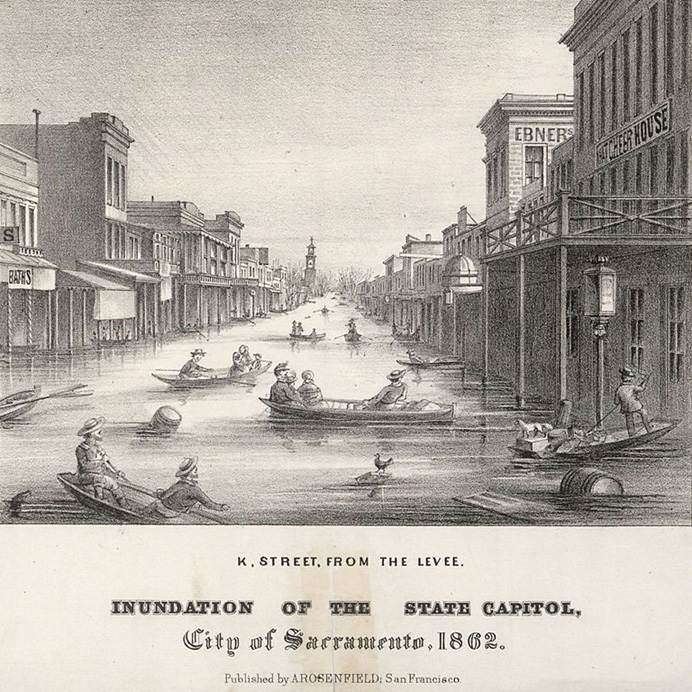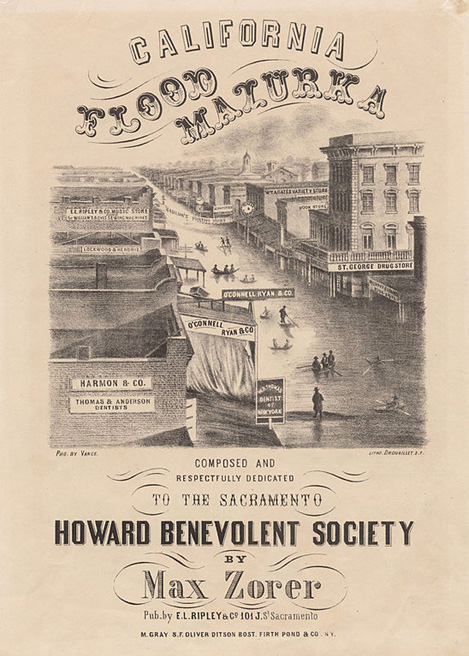
California is well known for droughts. But it also had one of the greatest floods in U.S. history.
In 1861, California had been in drought for 20 years.
Most of the state’s residents lived around San Francisco and in the Central Valley.
Ranchers there had been praying for rain for two decades. In November, they finally got it.
First, winter came early, bringing heavy snow to the mountain range that bounds the valley.
In December, temperatures rose, the snow melted and drained into the valley, saturating the soil.
Then the rains came—and didn’t stop for 43 days. Wave after wave of storms rolled in from the Pacific, bringing more than 10 feet of rain and snow.
Creeks became rivers, sweeping entire towns away. Rivers jumped their banks and cut new channels.
But much of the water was trapped in the Central Valley, which became an inland sea, stretching 300 miles north to south, in places 60 miles wide.
It took six months for this inland sea to evaporate and percolate into the ground. But the flood had destroyed a quarter of California’s taxable property and almost forced the state into bankruptcy.
It also wiped out nearly 1 million livestock animals, prompting the Central Valley to move away from ranching to become the agricultural powerhouse we know today.
Superstorms like this come along every 150 to 200 years, and we’ll talk more about them on a future EarthDate.
Background
Synopsis: In the 1840s and 1850s, California was exceptionally dry, so by the fall of 1861, California ranchers were hoping for rain. In late November they got what they were wishing for—and then some. It didn’t stop raining for 43 days, and by January 1862, the Central Valley was filled with an inland sea. It was the largest flood in the recorded history of California. Huge storms like these are now known as atmospheric rivers. Atmospheric rivers strike the U.S. West Coast several times a year on average, but can strike even more often in a particularly stormy year. Megastorm atmospheric rivers, like struck in 1861-1862, occur about every 150 to 200 years and probably pose a greater risk to the state than earthquakes.

- California became a state on September 9, 1850, in the middle of a crippling 20-year drought. By 1861, farmers and ranchers were praying for rain.
- In late November 1861, early winter storms dumped heavy snow in Northern California and Oregon. In early December, temperatures rose, and the snow started melting, saturating the parched soils of the Central Valley.
- On December 9, a huge storm rolled in from the Pacific, followed by waves of torrential storms along the West Coast from Mexico to Canada that lasted for weeks, filling streams, rivers and normally dry washes and lakebeds.
- By early January 1862, California was soaked, but on January 9, two superstorms hit back to back. On January 18, a heavy downpour lasted more than 24 hours, but finally brought an end to the 43-day deluge that had produced more than 10 ft (3 m) of rain and snow.
- As spring temperatures rose, the heavy snowpack melted, causing continued inundation of towns and fields in California and surrounding states for months.
- The Great Flood of 1861-1862 was the largest flood in the recorded history of California, Nevada and Oregon.
- Streams and rivers emanating from the Sierra Nevada Mountains became treacherous torrents, sweeping entire towns and mining camps away.
- The Central Valley became an inland sea that stretched 300 mi (480 km) from north to south and ranged from 12 to 60 mi (roughly 20 to 100 km) wide.
- The San Gabriel and San Diego rivers cut new channels to the sea, but severe flooding in Southern California was less devastating than farther north because it was very sparsely populated at the time, with only 11,333 people living in Los Angeles County.
- In 1860, the population of California was 379,994, and most lived in the Central Valley.
- California’s state capital, Sacramento, was located in a broad floodplain at the intersection of the Sacramento and American rivers.
- On January 10, 1862, the levees around Sacramento broke, flooding the city and forcing the newly elected governor, Leland Stanford, to travel by rowboat to the flooded capitol building for his soggy inauguration.
- On January 22, the entire state legislature relocated to San Francisco for six months while Sacramento dried out.
- At least 21 people died.
- Flooding destroyed one in eight houses and carried mining equipment great distances. As much as 25% of California’s taxable property was destroyed and the state was nearly forced to declare bankruptcy because of the costs of damages and the lost tax revenue.
- It is estimated that 100,000 sheep and 500,000 lambs were killed, and 200,000 of California’s 800,000 head of cattle drowned or starved. This forced California to change from a ranching economy to the prolific agricultural region we know today: America’s Salad Bowl.
- Today, scientists study atmospheric rivers and use the 1861-1862 storm as the basis for a “what-if” scenario they call ARkStorm—Atmospheric River 1,000 Storm. We’ll talk about these in the next episode of EarthDate.

